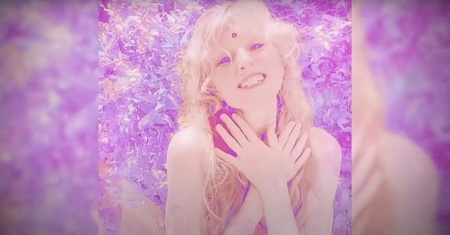
Ananda Xenia Shakti, frontwoman of Love Power the Band, has lived multiple musical lifetimes—first as a punk provocateur sharing stages with Blondie and The Clash, and now as a devotee of Bhakti yoga, creating vibrational music meant to dissolve boundaries between the sacred and the celebratory. Her latest single, “Hare Hare Dance,” from the album Songs from Source, is a luminous fusion of mantra, movement, and mysticism—an ecstatic offering that blurs the line between ritual and performance.
Built around the ancient Maha Mantra, “Hare Hare Dance” is less a conventional pop song than a sustained invocation, cycling through the names of Krishna and Radha with hypnotic insistence. But this isn’t cloistered chant music. It’s dynamic, pulsing with life and intention. The repetition doesn’t lull; it elevates. Set to a beat that borrows from both electronic dance and traditional Indian rhythms, the song makes a compelling case for joy as a radical act—and a path to transcendence.
The video, which juxtaposes scenes of sun-drenched devotion on the banks of the Yamuna River in Vrindavan with kinetic dance footage from Toronto’s Ecstatic Dance community, highlights the song’s central premise: that spiritual expression is not bound by geography, culture, or time. Shakti’s visual storytelling creates a non-linear, almost dreamlike narrative of unity. It’s not so much East meets West as East is West—simultaneously and continuously.
Vocally, Shakti delivers the mantra with a measured serenity, her tone anchored and clear. Rather than embellishing or straining for effect, she leans into the mantra’s rhythmic cadence and lets its intrinsic musicality do the work. The effect is immersive. Her presence—both aurally and visually—suggests someone not simply performing but inhabiting the music as a mode of being.
https://www.youtube.com/watch?v=jIVaeX9Ruhc
At its core, “Hare Hare Dance” is about embodiment. Shakti isn’t interested in delivering a message from above; she’s inviting you into the experience. “You are Love Power,” she declares—not metaphorically, but quite literally. The song’s structure, which avoids the usual verse-chorus-bridge architecture of Western pop, underscores this ethos. Instead, it flows in waves, more like breath than narrative.
There’s something quietly subversive about this project. In a pop landscape often defined by irony or detachment, Shakti offers full-throated sincerity. Her devotion is not stylized but felt, and “Hare Hare Dance” unfolds as both personal testimony and communal invitation. It asks not for belief, but for presence. In that sense, it aligns less with typical pop spectacle and more with the deeper roots of music itself: as a conduit for connection, transformation, and shared joy.
In Shakti’s world, dancing is praying, and chanting is remembering. “Hare Hare Dance” doesn’t chase commercial appeal. It seeks resonance—and in doing so, it finds it.
–John Parish
